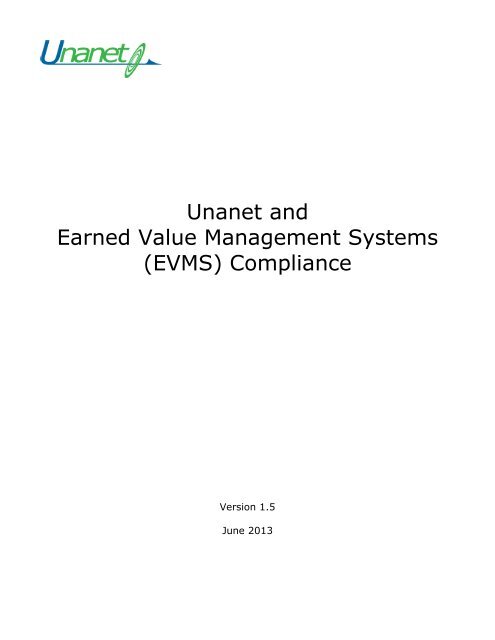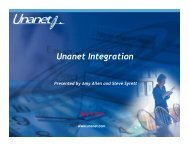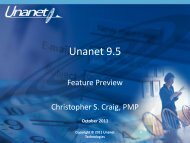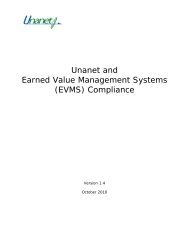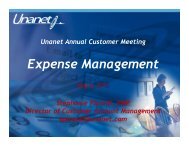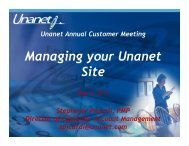Unanet, Earned Value Management Systems and ANSI Compliance
Unanet, Earned Value Management Systems and ANSI Compliance
Unanet, Earned Value Management Systems and ANSI Compliance
You also want an ePaper? Increase the reach of your titles
YUMPU automatically turns print PDFs into web optimized ePapers that Google loves.
<strong>Unanet</strong> <strong>and</strong><br />
<strong>Earned</strong> <strong>Value</strong> <strong>Management</strong> <strong>Systems</strong><br />
(EVMS) <strong>Compliance</strong><br />
Version 1.5<br />
June 2013
<strong>Unanet</strong> Overview<br />
<strong>Unanet</strong> Technologies<br />
45240 Business Court, Suite 300, Sterling, VA 20166<br />
P (703) 689-9440 F (703) 689-9450<br />
www.unanet.com<br />
<strong>Unanet</strong> web-based software helps organizations manage people <strong>and</strong> projects for improved profitability, project<br />
performance, compliance to government regulations <strong>and</strong> reduced costs. For example, <strong>Unanet</strong> customers have<br />
reduced timesheet <strong>and</strong> expense report processing costs by 90%. Beyond tactical improvements in efficiency,<br />
<strong>Unanet</strong> real time project reporting drives key decisions faster, improving effectiveness. <strong>Unanet</strong> software is<br />
categorized in the PSA (Professional Services Automation) <strong>and</strong> PPM (Project Portfolio <strong>Management</strong>) software<br />
industry.<br />
<strong>Unanet</strong> <strong>and</strong> <strong>Earned</strong> <strong>Value</strong> <strong>Management</strong><br />
<strong>Earned</strong> <strong>Value</strong> <strong>Management</strong> (EVM) is a project management methodology that effectively integrates the project<br />
scope of work with schedule <strong>and</strong> cost elements for optimum project planning <strong>and</strong> control. The qualities <strong>and</strong><br />
operating characteristics of earned value management systems are described in American National St<strong>and</strong>ards<br />
Institute (<strong>ANSI</strong>)/Electronic Industries Alliance (EIA) St<strong>and</strong>ard–748, <strong>Earned</strong> <strong>Value</strong> <strong>Management</strong> <strong>Systems</strong>,<br />
approved May 1998 <strong>and</strong> reaffirmed in August 2002, June 2007 (<strong>ANSI</strong> 748-B) <strong>and</strong> January 2013 (<strong>ANSI</strong> 748-C).<br />
The key concept in EVM is combining measurement of technical performance (the accomplishment of planned<br />
work) with schedule performance (is the project behind/ahead of schedule), <strong>and</strong> cost performance (is the<br />
project under/over budget). Without all three data points, it is impossible to tell if a project is on track to deliver<br />
the required scope within the schedule <strong>and</strong> budget goals.<br />
But adopting EVM in a practical <strong>and</strong> efficient way presents challenges for many government contractors, as<br />
while earned value management is a well established approach on Department of Defense systems projects<br />
tracing back to 1967, information technology <strong>and</strong> systems projects of all sizes have much less experience in<br />
adopting formal EVM systems. Consequently, IT professionals <strong>and</strong> contractors working with Civilian Agencies<br />
are often less familiar with implementation issues than their peers in the defense sector.<br />
The <strong>ANSI</strong>/EIA 748 St<strong>and</strong>ard identifies 32 criteria that should be complied with, grouped into five major<br />
categories:<br />
<br />
<br />
<br />
<br />
<br />
Organization of the project (five criteria)<br />
Planning, scheduling <strong>and</strong> budgeting (ten criteria)<br />
Accounting considerations (six criteria)<br />
Analysis <strong>and</strong> <strong>Management</strong> Reports (six criteria)<br />
Revisions <strong>and</strong> Data Maintenance (five criteria)<br />
In meeting these 32 criteria, an <strong>Earned</strong> <strong>Value</strong> <strong>Management</strong> System (EVMS) provides a structured set of<br />
management practices to establish a performance measurement baseline for a project, <strong>and</strong> then to measure<br />
<strong>and</strong> analyze achievement. The combination of comprehensive planning, disciplined maintenance of the baseline,<br />
<strong>and</strong> earned value analysis provides greater visibility into program performance. This not only helps ensure<br />
compliance with contract requirements, but also enables the contractor to have a much improved ability to take<br />
corrective action, <strong>and</strong> forecast project costs at completion based on performance to date.<br />
A formal EVMS is clearly more than a piece of software, <strong>and</strong> requires documented procedures, training <strong>and</strong><br />
ongoing process surveillance. However, appropriate automation can greatly reduce the effort of complying with<br />
the EVMS criteria <strong>and</strong> provide real project insight. The challenge is how to implement a system that supports<br />
these criteria with minimum overhead <strong>and</strong> which is appropriate for small <strong>and</strong> medium sized IT projects, while<br />
avoiding duplication of data, systems, <strong>and</strong> existing effort in project reporting <strong>and</strong> project accounting.<br />
The remainder of this document describes how <strong>Unanet</strong>, where appropriate, supports the 32 EVMS Criteria <strong>and</strong><br />
eliminates the need for additional <strong>and</strong> costly specialized software. Note that a number of government<br />
organizations do not require compliance with all 32 criteria, <strong>and</strong> instead focus on a “core” or “abridged” subset<br />
of 10 criteria.<br />
2
<strong>Unanet</strong> Technologies<br />
45240 Business Court, Suite 300, Sterling, VA 20166<br />
P (703) 689-9440 F (703) 689-9450<br />
www.unanet.com<br />
Organization of the Project<br />
EVMS Criteria 1: Define the authorized work elements for the program. A work breakdown structure (WBS),<br />
tailored for effective internal management control, is commonly used in this process.<br />
<strong>Unanet</strong> supports the definition of unlimited numbers of tasks <strong>and</strong> subtasks in a hierarchical Work Breakdown<br />
Structure within each project. Task-level time or expense reporting can be enforced, if needed.<br />
EVMS Criteria 2: Identify the program organizational structure, including major subcontractors responsible for<br />
accomplishing the authorized work, <strong>and</strong> define the organizational elements in which work will be planned <strong>and</strong><br />
controlled.<br />
<strong>Unanet</strong> provides organization-level management through Assignments. All tasks associated with a particular<br />
project can be assigned to specific people. Each person in the system is also assigned to particular “Home<br />
Organization.” Expenses can be reported on by Project or by Person Organization. Reports can be generated at<br />
the Project Organization or Person Organization level to track actual versus budget data at both the project <strong>and</strong><br />
task level.<br />
EVMS Criteria 3: Provide for the integration of the company’s planning, scheduling, budgeting, work<br />
authorization <strong>and</strong> cost accumulation processes with each other, <strong>and</strong> as appropriate, the program WBS <strong>and</strong> the<br />
program organizational structure.<br />
When utilizing <strong>Unanet</strong> Project Portfolio (the full <strong>Unanet</strong> suite), you have the ability to use the Planning module<br />
to plan <strong>and</strong> forecast future work, then convert a plan to an assignment (budget) when the project is won.<br />
Reporting at both the Project <strong>and</strong> Organization level provides a real time view into project performance, at<br />
summary, detailed <strong>and</strong> on a periodic basis. All data resides in a single database <strong>and</strong> the data model is<br />
published, so reporting requirements that fall outside the scope of the <strong>Unanet</strong>-provided reports can be<br />
accomplished with any common database reporting tool.<br />
EVMS Criteria 4: Identify the company organization or function responsible for controlling overhead (indirect<br />
costs).<br />
<strong>Unanet</strong> allows all indirect (<strong>and</strong> direct) work to be tracked with associated responsible organizations <strong>and</strong><br />
projects. Only approved or authorized personnel can record hours to each project or task.<br />
EVMS Criteria 5: Provide for integration of the program work breakdown structure <strong>and</strong> the program<br />
organizational structure in a manner that permits cost <strong>and</strong> schedule performance measurement by elements of<br />
either or both structures as needed.<br />
<strong>Unanet</strong> provides a detailed Work Breakdown structure with an associated responsible organization for all work,<br />
with comprehensive reporting on budgets, plans <strong>and</strong> actual hours <strong>and</strong> costs.<br />
Planning, Scheduling <strong>and</strong> Budgeting<br />
EVMS Criteria 6: Schedule the authorized work in a manner which describes the sequence of work <strong>and</strong> identifies<br />
the significant task interdependencies required to meet the requirements of the program.<br />
Task scheduling provides for enforceable beginning <strong>and</strong> end dates. <strong>Unanet</strong> supports an unlimited number of<br />
tasks <strong>and</strong> subtasks. <strong>Unanet</strong> allows dependencies between tasks to be defined <strong>and</strong> thus the logical sequences of<br />
tasks <strong>and</strong> their associated begin <strong>and</strong> end dates can be calculated. <strong>Unanet</strong> also integrates with Microsoft Project<br />
<strong>and</strong> doing so allows you to use the task dependency <strong>and</strong> critical path analysis features of Microsoft Project while<br />
maintaining a real time view of project performance in <strong>Unanet</strong>.<br />
3
<strong>Unanet</strong> Technologies<br />
45240 Business Court, Suite 300, Sterling, VA 20166<br />
P (703) 689-9440 F (703) 689-9450<br />
www.unanet.com<br />
EVMS Criteria 7: Identify physical products, milestones, technical performance goals or other indicators that will<br />
be used to measure progress.<br />
<strong>Unanet</strong> allows project managers to manually set percent complete figures based on milestones or performance<br />
measures that may be outside the scope of billable hours <strong>and</strong> expense management. <strong>Unanet</strong> can also<br />
objectively calculate percent complete based on hours charged or budget consumed to date. <strong>Unanet</strong> also<br />
provides User Defined Fields which can identify other appropriate objective methods for determining project <strong>and</strong><br />
task status by Project Managers.<br />
EVMS Criteria 8: Establish <strong>and</strong> maintain a time-phased budget baseline, at the control account level, against<br />
which program performance can be measured.<br />
Initial budgets established for performance measurement will be based on either internal management goals or<br />
the external customer-negotiated target cost, including estimates for authorized but undefinitized work.<br />
Budget for far-term efforts may be held in higher level accounts until an appropriate time for allocation at the<br />
control account level. On government contracts, if an over-target baseline is used for performance<br />
measurement reporting purposes; prior notification must be provided to the customer.<br />
In <strong>Unanet</strong>, the project manager can set the initial PMB based on project guidelines <strong>and</strong> budgets. Project<br />
forecasts that served as the basis of the estimate can be easily converted into a project plan with WBS <strong>and</strong> task<br />
assignments. Snapshots of budgets can be taken, as desired.<br />
<strong>Unanet</strong> can capture all costs via the <strong>Unanet</strong> user interface or through automated imports Typically, all direct<br />
labor <strong>and</strong> direct expense costs are captured via the <strong>Unanet</strong> user interface. Other Direct Costs (ODC) can be<br />
entered through the <strong>Unanet</strong> expense report user interface or imported automatically from an accounting<br />
system.<br />
Project Managers can also set up automatic notifications based on a variety of factors related to percent<br />
complete, budget consumption, etc.<br />
EVMS Criteria 9: Establish budgets for authorized work with identification of significant cost elements (labor,<br />
material, etc.) as needed for internal management <strong>and</strong> for control of subcontractors.<br />
<strong>Unanet</strong> applies controls so that staff can record effort or expense only against approved items, <strong>and</strong> separates<br />
labor <strong>and</strong> other expense costs.<br />
EVMS Criteria 10: To the extent it is practical to identify the authorized work in discrete work packages,<br />
establish budgets for this work in terms of dollars, hours, or other measurable units. Where the entire control<br />
account is not subdivided into work packages, identify the far term effort in larger planning packages for budget<br />
<strong>and</strong> scheduling purposes.<br />
<strong>Unanet</strong> allows the creation <strong>and</strong> authorization of detailed Work Breakdown Structures with budgets in hours or<br />
dollars, supporting the level of detail required for effective management of the project. Both budgeted amounts<br />
<strong>and</strong> dates can be used to constrain when charges are made against a project or task by an individual.<br />
EVMS Criteria 11: Provide that the sum of all work package budgets plus planning package budgets within a<br />
control account equals the control account budget.<br />
<strong>Unanet</strong> supports summarization of budget hours <strong>and</strong> costs from detail levels for comparison with summary or<br />
project-level budgets.<br />
4
<strong>Unanet</strong> Technologies<br />
45240 Business Court, Suite 300, Sterling, VA 20166<br />
P (703) 689-9440 F (703) 689-9450<br />
www.unanet.com<br />
EVMS Criteria 12: Identify <strong>and</strong> control level of effort activity by time-phased budgets established for this<br />
purpose. Only that effort which is unmeasurable or for which measurement is impractical may be classified as<br />
level of effort.<br />
<strong>Unanet</strong> provides a time-phased detailed WBS with associated hours <strong>and</strong> budgets. Level of effort activities where<br />
budgets are spread across the duration of the project are also supported.<br />
EVMS Criteria 13: Establish overhead budgets for each significant organizational component of the company for<br />
expenses which will become indirect costs. Reflect in the program budgets, at the appropriate level, the<br />
amounts in overhead pools that are planned to be allocated to the program as indirect costs.<br />
<strong>Unanet</strong> supports burdening of projects costs by applying indirect rates using target, provisional <strong>and</strong> actual<br />
rates. Multiple costs structures are supported. Various reports are provided, including actuals <strong>and</strong> forecasting<br />
future costs based on staffing, to show in detail how overhead costs are applied to projects to give total costs.<br />
EVMS Criteria 14: Identify management reserves <strong>and</strong> undistributed budget.<br />
<strong>Unanet</strong> provides a number of flexible mechanisms at the project level for recording data such as management<br />
reserve (MR) <strong>and</strong> undistributed budget (UB), via User Defined Fields <strong>and</strong> Project Notes.<br />
EVMS Criteria 15: Provide that the program target cost goal is reconciled with the sum of all internal program<br />
budgets <strong>and</strong> management reserves.<br />
<strong>Unanet</strong> provides various reports which rollup budget hours <strong>and</strong> costs from detailed to project <strong>and</strong> other<br />
summary levels for comparison with target costs.<br />
Accounting Considerations<br />
EVM Intent Guideline 16: Record direct costs in a manner consistent with the budgets in a formal system<br />
controlled by the general books of account.<br />
<strong>Unanet</strong> will be your system of record for time, <strong>and</strong> for time adjustments. Your accounting systems remains your<br />
system of record for project accounting data as the time details flow into the accounting system. <strong>Unanet</strong><br />
integrates with all leading accounting systems.<br />
EVM Intent Guideline 17: When a work breakdown structure is used, summarize direct costs from control<br />
accounts into the work breakdown structure without allocation of a single control account to two or more work<br />
breakdown structure elements.<br />
<strong>Unanet</strong> allows budgeting <strong>and</strong> actual tracking at the lowest level of detail required, so that this issue does not<br />
occur. Information can be rolled up by the WBS for summary reporting.<br />
EVM Intent Guideline 18: Summarize direct costs from the control accounts into the contractor's organizational<br />
elements without allocation of a single control account to two or more organizational elements.<br />
<strong>Unanet</strong> allows direct costs from the accounting system to be applied at the same level as budgets within<br />
<strong>Unanet</strong>. Information can be rolled up by the WBS for summary reporting.<br />
EVM Intent Guideline 19: Record all indirect costs which will be allocated to the contract.<br />
<strong>Unanet</strong> provides a set of summary <strong>and</strong> detailed project reports which calculate <strong>and</strong> display indirect costs to be<br />
applied to a project. Indirect costs can be calculated using three different rate types; target, provisional <strong>and</strong><br />
actual.<br />
5
<strong>Unanet</strong> Technologies<br />
45240 Business Court, Suite 300, Sterling, VA 20166<br />
P (703) 689-9440 F (703) 689-9450<br />
www.unanet.com<br />
EVM Intent Guideline 20: Identify unit costs, equivalent units costs, or lot costs when needed.<br />
<strong>Unanet</strong> provides flexible <strong>and</strong> powerful integration facilities with leading accounting systems. Where unit cost or<br />
lot cost data needs to be stored in <strong>Unanet</strong>, there are a number of User Defined Fields that can support this.<br />
EVM Intent Guideline 21: For EVMS, the material accounting system will provide for:<br />
21.1: Accurate cost accumulation <strong>and</strong> assignment of costs to control accounts in a manner consistent with the<br />
budgets using recognized, acceptable, costing techniques.<br />
21.2: Cost performance measurement at the point in time most suitable for the category of material involved,<br />
but no earlier than the time of progress payments or actual receipt of material.<br />
21.3: Full accountability of all material purchased for the program including the residual inventory<br />
This functionality would typically be provided by the accounting system. Material costs recorded in <strong>Unanet</strong> can<br />
be exported to the accounting system through automated interfaces. Similarly, actual material costs can be<br />
imported into <strong>Unanet</strong> <strong>and</strong> applied at the appropriate level for comparison with budget data.<br />
Analysis <strong>and</strong> <strong>Management</strong> Reports<br />
EVM Intent Guideline 22: At least on a monthly basis, generate the following information at the control account<br />
<strong>and</strong> other levels as necessary for management control using actual cost data from, or reconcilable with, the<br />
accounting system:<br />
a) Comparison of the amount of planned budget <strong>and</strong> the amount of budget earned for work accomplished<br />
– SCHEDULE VARIANCE<br />
b) Comparison of the amount of the budget earned <strong>and</strong> the actual (applied where appropriate) directs<br />
costs for the same work. – COST VARIANCE<br />
<strong>Unanet</strong> calculates <strong>and</strong> reports Budgeted Cost of Work Scheduled, Budgeted Cost of Work Performed, Actual<br />
Cost of Work Performed, Schedule <strong>and</strong> Cost Variance, Schedule <strong>and</strong> Cost Variance Percentage, Schedule <strong>and</strong><br />
Cost Performance Indices, Budget At Complete, Estimate at Complete <strong>and</strong> Variance at Complete. This data can<br />
be calculated for a user-specified ‘current period’ <strong>and</strong> also cumulatively for the life of the project.<br />
EVM Intent Guideline 23: Identify, at least monthly, the significant differences between both planned <strong>and</strong> actual<br />
schedule performance <strong>and</strong> planned <strong>and</strong> actual cost performance, <strong>and</strong> provide the reasons for the variances in<br />
the detail needed by program management.<br />
<strong>Unanet</strong> provides reports detailing schedule <strong>and</strong> cost performance variance <strong>and</strong> indices, <strong>and</strong> allows project<br />
managers to document reasons for variances as required, based on needs <strong>and</strong> thresholds established by<br />
program management. Specific thresholds for cost <strong>and</strong> schedule variances, <strong>and</strong> variance at complete, can be<br />
specified in reporting so that those items requiring management attention are easily identified.<br />
EVM Intent Guideline 24: Identify budgeted <strong>and</strong> applied (or actual) indirect costs at the level <strong>and</strong> frequency<br />
needed by management for effective control, along with the reasons for any significant variances.<br />
<strong>Unanet</strong> provides a suite of summary <strong>and</strong> detailed reports showing budgeted <strong>and</strong> actual indirect costs. Indirect<br />
costs can be calculated using target, provisional or actual burden rates. <strong>Unanet</strong> provides facilities for recording<br />
Notes where reasons for variances can be documented.<br />
EVM Intent Guideline 25: Summarize the data elements <strong>and</strong> associated variances through the program<br />
organization <strong>and</strong>/or work breakdown structure to support management needs <strong>and</strong> any customer reporting<br />
specified in the contract.<br />
In <strong>Unanet</strong>, budget, actual <strong>and</strong> earned value data are held at the detail level. This information can be<br />
summarized to any level of the WBS, <strong>and</strong> variances used for analysis <strong>and</strong> problem resolution.<br />
6
<strong>Unanet</strong> Technologies<br />
45240 Business Court, Suite 300, Sterling, VA 20166<br />
P (703) 689-9440 F (703) 689-9450<br />
www.unanet.com<br />
EVM Intent Guideline 26: Implement managerial actions taken as the result of earned value information.<br />
In <strong>Unanet</strong>, action items with associated responsibilities can be recorded in the Project Notes facility, <strong>and</strong> tracked<br />
to completion <strong>and</strong> adequate resolution. <strong>Unanet</strong> provides relevant managers with real-time access to project<br />
performance data that allows them to identify variances.<br />
EVM Intent Guideline 27: Develop revised estimates of cost at completion based on performance to date,<br />
commitment values for material, <strong>and</strong> estimates of future conditions. Compare this information with the<br />
performance measurement baseline to identify variances at completion important to company management <strong>and</strong><br />
any applicable customer reporting requirements including statements of funding requirements.<br />
<strong>Unanet</strong> provides this data in real-time. Projects Managers can see estimates to completion on a constant basis,<br />
<strong>and</strong> are better able to manage the project to on time / on budget completion because they have access in realtime<br />
to the direct costs related to their projects. Indirect costs can be calculated <strong>and</strong> displayed as required<br />
based on target, provisional or actual burden rates to provide a complete picture of project status.<br />
Revisions <strong>and</strong> Data Maintenance<br />
EVM Intent Guideline 28: Incorporate authorized changes in a timely manner, recording the effects in budget<br />
<strong>and</strong> schedules. In the directed effort prior to negotiation of a change, base such revisions on the amount<br />
estimated <strong>and</strong> budgeted to the program organizations.<br />
<strong>Unanet</strong> captures budget <strong>and</strong> schedule changes in the audit trail <strong>and</strong> also via a user-generated snapshot with a<br />
specified effective date. Further, the real-time view for project managers provides the earliest possible<br />
recognition of potential problems <strong>and</strong> thus the best opportunity to mitigate those problems before they threaten<br />
the project schedule.<br />
EVM Intent Guideline 29: Reconcile current budgets to prior budgets in terms of changes to the authorized work<br />
<strong>and</strong> internal replanning in the detail needed by management for effective control.<br />
<strong>Unanet</strong> allows ‘snapshots’ to be recorded of both project <strong>and</strong> task budgets, <strong>and</strong> percent complete, as required<br />
by the project manager. <strong>Unanet</strong>’s audit trail capabilities enable management to achieve this level of control.<br />
Furthermore, original plans <strong>and</strong> budgets can be compared.<br />
EVM Intent Guideline 30: Control retroactive changes to records pertaining to work performed that would<br />
change previously reported amounts for actual costs, earned value, or budgets. Adjustments should be made<br />
only for correction of errors, routine accounting adjustments, effects of customer or management directed<br />
changes, or to improve the baseline integrity <strong>and</strong> accuracy of performance measurement data.<br />
<strong>Unanet</strong> provides control over historical adjustments <strong>and</strong> can enforce recording of reasons for changes made. A<br />
detailed audit trail is recorded of any authorized changes made, in full compliance with DCAA timekeeping<br />
requirements.<br />
EVM Intent Guideline 31: Prevent revisions to the program budget except for authorized changes.<br />
<strong>Unanet</strong> provides comprehensive security access control including project <strong>and</strong> organization-level access, roles<br />
that control access, <strong>and</strong> an audit functionality.<br />
EVM Intent Guideline 32: Document changes to the performance measurement baseline.<br />
<strong>Unanet</strong> provides facilities for recording Notes against a project to support those changes recorded by the Audit<br />
functionality that require annotation <strong>and</strong> explanation.<br />
7


